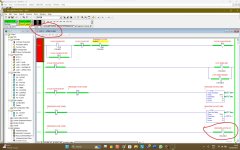Hello Guys,
Hope everyone is doing well.
I have a general doubt about ladder programming.
The outputs are not getting energized when I used the input contacts of the outputs and the binary bits in another program file (lad 3, lad 4...) other than lad 2.
From my quick surf through the forum, I saw something called "Last Rung Rule"
Is that what causes the restriction?
I am a beginner in the Plc, so the way scanning works is still causing confusion to me.
Please post your guidance and opinions.
cheers.
Hope everyone is doing well.
I have a general doubt about ladder programming.
The outputs are not getting energized when I used the input contacts of the outputs and the binary bits in another program file (lad 3, lad 4...) other than lad 2.
From my quick surf through the forum, I saw something called "Last Rung Rule"
Is that what causes the restriction?
I am a beginner in the Plc, so the way scanning works is still causing confusion to me.
Please post your guidance and opinions.
cheers.





